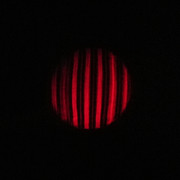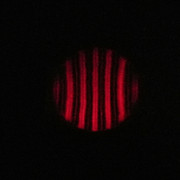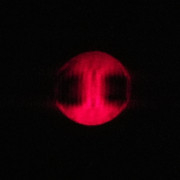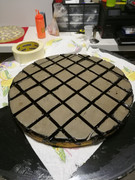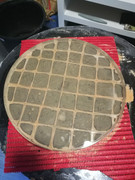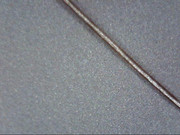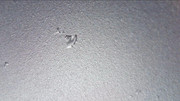Forum Replies Created
-
AuthorPosts
-
In what sense Massimo? The first is with the reticle furthest from the focus (then moving away from the mirror), the second is with the closest lattice (approaching the mirror), the third in the area close to the focus which, however, varies a lot at the slightest movement and the photo makes little text. I have no idea of anything else besides this

Theoretically I should have a sphere and if I move the reticle further away the lines seem straighter but at the distance I took the photos they seem to have this trend more like a parabola.
For now I'm working with 1 / 3D passes and mirror above, I wanted to reverse for a couple of hours tonight but then I got caught up with this pseudo test and postponed.
Edit:
Exactly as you say, the edge is not yet well worked, so much so that the imprint is more visible when tested with an incident laser than the 2/3 more central.
So you say I'm fine for this road?therefore, I could not resist and tonight I tried to create a Ronchi lattice with a fishing line from 0,1 mm that I had at home… then I removed the collimating lens from a laser, I placed the reticle in the back focus from the mirror and not being able to look directly at the too dangerous laser light I projected the fringes on a sheet, then I photographed with my mobile phone so take the images with a grain of salt given the unprofessional crotch used.
From what I see I do not know if I have pulled it but I seem to be in the situation exposed as a question
Trying to move back and forth as best I can, I don't feel like I have riveted edges or other extreme devilry.
The mirror is not yet properly polished, the laser test still shows the print on the good face (I am at 4 or 5 work hours) and of course I'll wait until I'm finished and receive the actual reticles to use with a more serious test.
in conclusion, that seems to you?
(In the images the curves seem a little distorted in some places but live they are not, I do not know if it is the paper not well stretched or the camera but moving you can see regular)I got the one from 200 lines because they more or less are 8 per millimeter… I also took the other one in anticipation of future works. I have several simulation software and it seemed to me that just for mine they were sufficient.
But one question… Suppose that by doing a Ronchi test, not a sphere but a principle of parabola emerged, in that case it is advisable to search for the sphere in any case by inverting the tool and mirror or if the mirror is already properly polished you can continue bypassing the sphere?Thanks for the tips guys, in the end I chose to try to buy a couple of grids from the site that Giulio gave me, one from 125 lp / inch or 4,92 lines per mm and one from 200 lp / inch that correspond to 7,87 lines per mm. For about twenty euros including shipping you can try

Somewhere around the house I should have a film SLR, but even if I found it again, it seems a bit too cumbersome nowadays… although it is a qualitatively efficient method, it is not for the entire roll purchase process, model photography, development etc.
In the meantime, I continue to polish and we hope it won't take years to arrive!Thank you guys, for now I am satisfied with the progress. I begin to understand more and more things and this is above all thanks to you and to San Giulio who fills me with extra useful material.
Tonight after a few hours of polishing I was finally able to measure the real focal length of the mirror. By removing the lens from a laser pointer fixed on a support and directing it towards the mirror, I tried to accurately identify the return focus and consequently the radius of curvature which turned out to be 3608 mm.
So at the moment the focal length of 1804 mm appears to be in line with the initial goal of obtaining an F / 6 ratio.
Over the next few days I will focus on building a mirror holder and setup to perform the Ronchi and Foucault tests.
Rather, does anyone know where to find a semi-reflective mirror? I would like to build a rather precise test bench so that it can be used better even with multiple mirrors “fast” (mmm… and, I have the doubt that I will continue my career as a scratch glass ).
).
The Ronchi reticle I have yet to see how to create it because I do not have precise laser printers available and with the fishing line it is a bit cumbersome.
I found an American shop that truly has everything I need (the famous edmund optics) but it has hallucinating prices and in addition being in america times, costs, customs scare me a little. If you have other options I'm all ears
Thank you Giulio, great advice… luckily it came naturally to me to work already pushing and pulling only the edge of the mirror, touching as little surface as possible, This is to get used to not heating glass areas close to the face with my fingers.
A little tip for those who want to open the channels using a soldering iron (or similar methods by casting).
I learned that by masking the pitch with paper tape, delimiting the channels to be opened, comes a very neat and precise job, the pitch does not get dirty or deform as it did the first time with consequent difficulty in making contact with the surface again.
In practice, vertical strips are taped, leaving the spaces of the desired channels uncovered, then the tool is placed almost vertically with a container underneath where the discharged pitch will be poured. It starts from the bottom and begins to dissolve the channels gradually rising towards the middle of the tool. It starts from the bottom so that the pitch that melts upstream already finds the drainage channel free and does not take unwanted roads. In order not to have to make the pitch go too far higher, I found it useful to reach halfway through the tool, then turn it 180 ° and complete the other half.
Remove the tape, place new strips at 90 ° and do the same operations to obtain the grid.
I have to change my mind about this method, I was the wrong approach. Simply marking the channels with the pressure of a V-shaped tool means moving the pitch from one place to another without removing it with the consequence that the shape of the tool is deformed more and above all that the tendency of the channels to close is greater. However, by removing the material from the channels these problems do not arise and also the adaptation phase is practically immediate.I managed to make everything work well, needed more weight for longer. So let's say we have it but the problem remains the too high temperature in my studio, alas the only room in the house without air conditioner. 31° C are many and my pitch is suitable for working temperatures ranging from 18 to 26 degrees approximately, consequently the canals have almost closed after an hour and now I think I should wait for the weekend and the expected drop in temperature. However, it is already a good sign that everything works and that the momentary loss was just a problem of “shape”

(Here still not completely in contact)
As I suspected the pitch tool is driving me crazy…I did the casting without problems and I kept the mirror and the tool pressed to make the pitch take the right shape, after which I opened the channels with the soldering iron as suggested by many. Biggest mistake I couldn't make. Apart from the smell despite being on the terrace, but when I finished opening I had to press again long enough to have a homogeneous contact. Only in the meantime the channels have partially closed and then off to the welder again… At the moment I have dirty everywhere, I also have pitch behind my ears and a bit of despair that I will try to make go away with a good ice cold beer. Now I'm trying to make it take shape again.

Update: Nothing, I can't slide the tool even though it is now in contact everywhere. I do two or three times back and forth freezes and no longer flows, it doesn't matter if you put more or less abrasive, more or less water. I do not know what to do.
Ok, the plaster tool is ready but the anxiety is palpable…
I'm not so sure I'm using le anymore “squares "Candy"” pitch because they involve a whole series of steps that, having never had to deal with a substance like this, I don't feel like facing (mold creation, casting into molds, removal from molds, fusion and sticking of the back of each square etc.).
It seems to give me more confidence to face the classic tool-pitch-mirror sandwich and subsequent channel creation.
What do you think?Today I worked the mirror for an hour with grit 5 microns. At the moment I do not detect any crater and the surface is satisfactory in each zone. I started checking with the microscope the center and gradually from outlying areas not experiencing changes. I have seen with pleasure that the finer grits require much less work and above all much less fatigue. from 15 microns onwards (15-9-5-3) I opted for an emulsion consisting of 1 part of abrasive 4 parts water and two or three drops of good durability of dried experiencing mild soap that I never left “Pull” too much… He changed slightly as the sound of the past I added a sprinkling of mixture.
I alternated mot and tot maintaining a pass 1 / 3D which has proved ideal to keep the ball and control with precision and lightness mirror and the tool.
Tomorrow I will use the grain from 3 micron despite many do not use these fine grits so passing immediately to step polishing simply keeping it for a longer duration. I preferred to take well-advanced in abrasive to manage in a less challenging the already perceived as tough polishing stage.
Here is the image of a hair compared to finish by 5 microns:For polishing I will opt for a completely new tool, always in dental plaster, that most likely I will create with the technique of “squares "Candy"” pitch.
Another thing to do in a week will be a grid of rhonchi with fishing wire 0,125mm and the setup of a test foucault.
Good evening everybody!Since an error was born the solution to the problem. Practically I was wrong sequence of abrasives skipping 25 microns. I realized just tonight of being passed from grain 320 to the 15 (of drawers error reversed) and so, even though I had cumunque now well-worked surface, I decided to return to 25 and the craters are floor plan disappeared!

Come on!So guys, After a few days off I went back under. They are the grit 15 microns and the surface starts to become more and more velvety and pleasant

The arrow continues to be stable and I continue to alternate Mot and Tot, I measured the focal with a laser wetting the mirror and measures 1805 mm so we. What I did for a while to think about right now are the 3 or 4 craters that I found with the microscope (that look very big but very magnified because almost invisible to the naked eye). I am alone 3 or 4, of which I am attaching photos of the largest, and the question is: you think, They will fall into place on their own even though he is already using quite fine grits? And in the case they would not be in place that you? They leave them or you go back to work? The impact on the final product? In your mirrors you have left? For precision two are almost in the center and then view the obstruction of the secondary should not give any discomfort, the other two in one half and one to a few cm from the edge. Anyway I hope to fall into place…Sorry for the questions in bursts but fussy as I'm paranoid
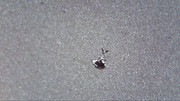
Thanks Massimo, glad to know not to be the only psycho around

No Seriously, I think they are the details that make the difference between a successful business and one that “You could have been done better” (then you can always do better anyway), so I like to pay attention to the little things.
Today I got the usb microscope, It paid € 29 turns out to be very formidable.

I then searched for the presence of craters on the surface and the only noteworthy is this, compared to the size of my hair:
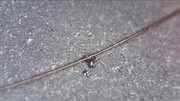
I will work a little longer with 320 and then I pass to 25my
We came to the grain 320, I've done work an hour and the surface seems very homogeneous and free of craters:
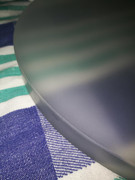
Wednesday should get me the microscope usb to control the surface with the advance of finer grits… Now I have a couple of little questions for you.
What is the best way to assess the scope of this processing stage? That, you have to take the pencil / pen test for good or there are other methods more precise? The focal distance is measured by wetting the mirror is fine, the arrow corresponds to the calculations (although in reality, for completeness, I wanted to see the value because with the bevel angles of the mirror measured 298,5mm and the arrow was then dropped by a couple of tenths to stay in the correct focal), the marker test continues to be homogeneous, however I can not be sure of the correct sphericity. We should wait for a good polishing and consequently the true optical test and own or is there a feasible way these stages? My fear is getting ahead with some unrecoverable error if not going back with grits
Theoretically it should be alright… I think… I hope…
Another question, I read an article where it was suggested to add a soap goccino in finer grits to be used in emulsion, ie a part of abrasive, 3 parts of water and a few drop of soap and lather all. Reported the advantage of dried longer and more manageable. Have you ever tried? In your experience could be an effective board? -
AuthorPosts
